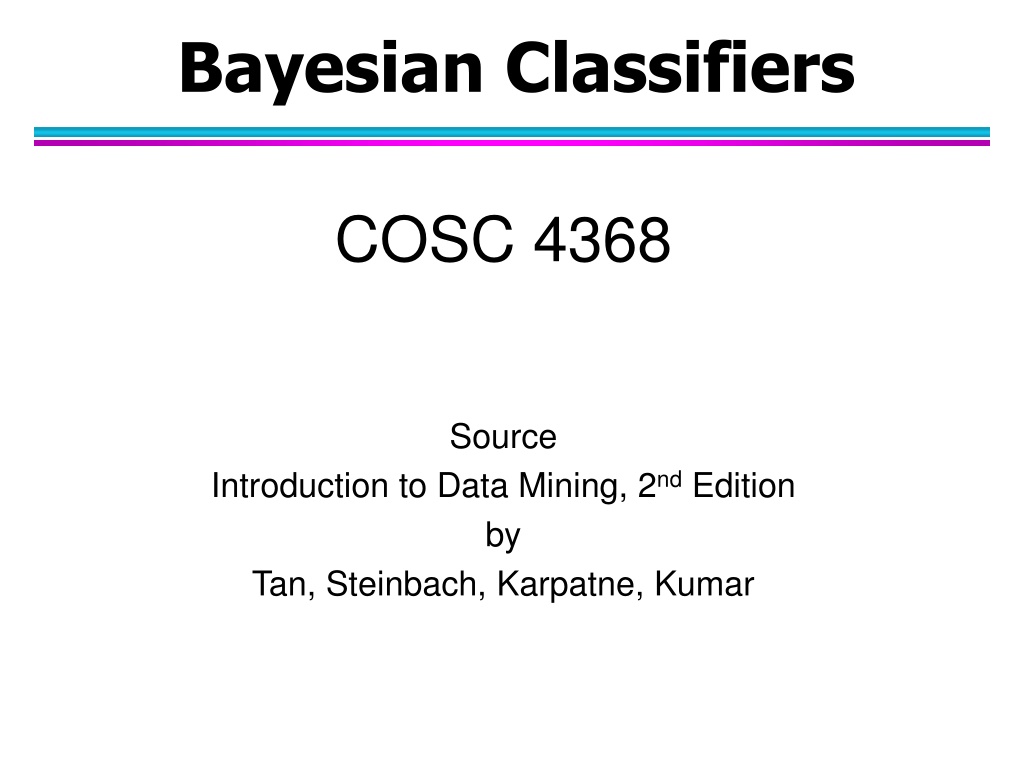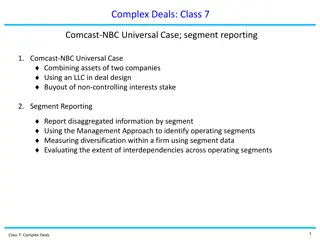
Bayesian Classifiers in Data Mining
"Learn about Bayesian Classifiers and their application in data mining, including Nave Bayes Classifier, Bayes Theorem examples, and using Bayes Theorem for classification. Understand how to estimate probabilities and compute posterior probabilities for classification problems."
Download Presentation

Please find below an Image/Link to download the presentation.
The content on the website is provided AS IS for your information and personal use only. It may not be sold, licensed, or shared on other websites without obtaining consent from the author. If you encounter any issues during the download, it is possible that the publisher has removed the file from their server.
You are allowed to download the files provided on this website for personal or commercial use, subject to the condition that they are used lawfully. All files are the property of their respective owners.
The content on the website is provided AS IS for your information and personal use only. It may not be sold, licensed, or shared on other websites without obtaining consent from the author.
E N D
Presentation Transcript
Bayesian Classifiers COSC 4368 Source Introduction to Data Mining, 2nd Edition by Tan, Steinbach, Karpatne, Kumar
Nave Bayes Classifier A probabilistic framework for solving classification problems Conditional Probability: ( P , ) P X Y = ( | ) P Y X ( X ) X ( P , ) P Y = ( | ) P X Y ( ) Y Bayes theorem: ( | ) ( ) P X Y P Y = ( | ) P Y X ( ) P X 04/04/2020 COSC 4368 2
Example of Bayes Theorem Given: A doctor knows that meningitis causes stiff neck 50% of the time Prior probability of any patient having meningitis is 1/50,000 Prior probability of any patient having stiff neck is 1/20 If a patient has stiff neck, what s the probability he/she has meningitis? / 1 ( | ) ( ) 5 . 0 50000 P S M P M = = = ( | ) 0002 . 0 P M S ( ) / 1 20 P S 04/04/2020 COSC 4368 3
Using Bayes Theorem for Classification Consider each attribute and class label as random variables Given a record with attributes (X1, X2, , Xd) Goal is to predict class Y Specifically, we want to find the value of Y that maximizes P(Y| X1, X2, , Xd ) Can we estimate P(Y| X1, X2, , Xd ) directly from data? 04/04/2020 COSC 4368 4
Example Data Given a Test Record: categorical categorical continuous = = = Refund ( No, Divorced, Income 120K) X class Can we estimate P(Evade = Yes | X) and P(Evade = No | X)? Tid Refund Marital Taxable Income Evade Status 1 Yes Single 125K No 2 No Married 100K No 3 No Single 70K No In the following we will replace Evade = Yes by Yes, and Evade = No by No 4 Yes Married 120K No 5 No Divorced 95K Yes 6 No Married 60K No 7 Yes Divorced 220K No 8 No Single 85K Yes 9 No Married 75K No 10 No Single 90K Yes 10 04/04/2020 COSC 4368 5
Using Bayes Theorem for Classification Approach: compute posterior probability P(Y | X1, X2, , Xd) using the Bayes theorem ( | ) ( ) P X X X Y P Y = ( | ) 1 P 2 X P Y X X X d 1 2 n ( ) X X 1 2 d Maximum a-posteriori: Choose Y that maximizes P(Y | X1, X2, , Xd) Equivalent to choosing value of Y that maximizes P(X1, X2, , Xd|Y) P(Y) How to estimate P(X1, X2, , Xd | Y )? 04/04/2020 COSC 4368 6
Example Data Given a Test Record: categorical categorical continuous = = = Refund ( No, Divorced, Income 120K) X class Tid Refund Marital Taxable Income Evade Status 1 Yes Single 125K No 2 No Married 100K No 3 No Single 70K No 4 Yes Married 120K No 5 No Divorced 95K Yes 6 No Married 60K No 7 Yes Divorced 220K No 8 No Single 85K Yes 9 No Married 75K No 10 No Single 90K Yes 10 04/04/2020 COSC 4368 7
Nave Bayes Classifier Assume independence among attributes Xi when class is given: P(X1, X2, , Xd |Yj) = P(X1| Yj) P(X2| Yj) P(Xd| Yj) Now we can estimate P(Xi| Yj) for all Xi and Yj combinations from the training data New point is classified to Yj if P(Yj) P(Xi| Yj) is maximal. 04/04/2020 COSC 4368 8
Nave Bayes on Example Data Given a Test Record: categorical categorical continuous = = = Refund ( No, Divorced, Income 120K) X class Tid Refund Marital Taxable Income Evade P(X | Yes) = Status P(Refund = No | Yes) x P(Divorced | Yes) x P(Income = 120K | Yes) 1 Yes Single 125K No 2 No Married 100K No 3 No Single 70K No 4 Yes Married 120K No 5 No Divorced 95K Yes 6 No Married 60K No P(X | No) = 7 Yes Divorced 220K No P(Refund = No | No) x P(Divorced | No) x P(Income = 120K | No) 8 No Single 85K Yes 9 No Married 75K No 10 No Single 90K Yes 10 04/04/2020 COSC 4368 9
Estimate Probabilities from Data categorical categorical continuous class l Class: P(Y) = Nc/N e.g., P(No) = 7/10, P(Yes) = 3/10 Tid Refund Marital Taxable Income Evade Status 1 Yes Single 125K No l For categorical attributes: P(Xi | Yk) = |Xik|/ Nc 2 No Married 100K No 3 No Single 70K No 4 Yes Married 120K No k 5 No Divorced 95K Yes where |Xik| is number of instances having attribute value Xi and belonging to class Yk Examples: 6 No Married 60K No 7 Yes Divorced 220K No 8 No Single 85K Yes 9 No Married 75K No 10 No Single 90K Yes P(Status=Married|No) = 4/7 P(Refund=Yes|Yes)=0 10 04/04/2020 COSC 4368 10
Estimate Probabilities from Data For continuous attributes: Discretization: Partition the range into bins: Replace continuous value with bin value Attribute changed from continuous to ordinal l k Probability density estimation: Assume attribute follows a normal distribution Use data to estimate parameters of distribution (e.g., mean and standard deviation) Once probability distribution is known, use it to estimate the conditional probability P(Xi|Y) 04/04/2020 COSC 4368 11
Example of Nave Bayes Classifier Given a Test Record: = = = Refund ( No, Divorced, Income 120K) X Na ve Bayes Classifier: P(Refund = Yes | No) = 3/7 P(Refund = No | No) = 4/7 P(Refund = Yes | Yes) = 0 P(Refund = No | Yes) = 1 P(Marital Status = Single | No) = 2/7 P(Marital Status = Divorced | No) = 1/7 P(Marital Status = Married | No) = 4/7 P(Marital Status = Single | Yes) = 2/3 P(Marital Status = Divorced | Yes) = 1/3 P(Marital Status = Married | Yes) = 0 P(X | No) = P(Refund=No | No) = 4/7 1/7 0.0072 = 0.0006 P(Divorced | No) P(Income=120K | No) P(X | Yes) = P(Refund=No | Yes) P(Divorced | Yes) P(Income=120K | Yes) = 1 1/3 1.2 10-9 = 4 10-10 For Taxable Income: If class = No: sample mean = 110 sample variance = 2975 If class = Yes: sample mean = 90 sample variance = 25 Since P(X|No)P(No) > P(X|Yes)P(Yes) Therefore P(No|X) > P(Yes|X) => Class = No 04/04/2020 COSC 4368 12
Example of Nave Bayes Classifier Given a Test Record: = = = Refund ( No, Divorced, Income 120K) X Na ve Bayes Classifier: P(Yes) = 3/10 P(No) = 7/10 P(Refund = Yes | No) = 3/7 P(Refund = No | No) = 4/7 P(Refund = Yes | Yes) = 0 P(Refund = No | Yes) = 1 P(Marital Status = Single | No) = 2/7 P(Marital Status = Divorced | No) = 1/7 P(Marital Status = Married | No) = 4/7 P(Marital Status = Single | Yes) = 2/3 P(Marital Status = Divorced | Yes) = 1/3 P(Marital Status = Married | Yes) = 0 P(Yes | Divorced) = 1/3 x 3/10 / P(Divorced) P(No | Divorced) = 1/7 x 7/10 / P(Divorced) P(Yes | Refund = No, Divorced) = 1 x 1/3 x 3/10 / P(Divorced, Refund = No) P(No | Refund = No, Divorced) = 4/7 x 1/7 x 7/10 / P(Divorced, Refund = No) For Taxable Income: If class = No: sample mean = 110 sample variance = 2975 If class = Yes: sample mean = 90 sample variance = 25 04/04/2020 COSC 4368 13
Issues with Nave Bayes Classifier Na ve Bayes Classifier: P(Yes) = 3/10 P(No) = 7/10 P(Refund = Yes | No) = 3/7 P(Refund = No | No) = 4/7 P(Refund = Yes | Yes) = 0 P(Refund = No | Yes) = 1 P(Marital Status = Single | No) = 2/7 P(Marital Status = Divorced | No) = 1/7 P(Marital Status = Married | No) = 4/7 P(Marital Status = Single | Yes) = 2/3 P(Marital Status = Divorced | Yes) = 1/3 P(Marital Status = Married | Yes) = 0 P(Yes | Married) = 0 x 3/10 / P(Married) P(No | Married) = 4/7 x 7/10 / P(Married) For Taxable Income: If class = No: sample mean = 110 sample variance = 2975 If class = Yes: sample mean = 90 sample variance = 25 04/04/2020 COSC 4368 14
Issues with Nave Bayes Classifier categorical categorical continuous class Na ve Bayes Classifier: Consider the table with Tid = 7 deleted Tid Refund Marital Taxable Income P(Refund = Yes | No) = 2/6 P(Refund = No | No) = 4/6 P(Refund = Yes | Yes) = 0 P(Refund = No | Yes) = 1 P(Marital Status = Single | No) = 2/6 P(Marital Status = Divorced | No) = 0 P(Marital Status = Married | No) = 4/6 P(Marital Status = Single | Yes) = 2/3 P(Marital Status = Divorced | Yes) = 1/3 P(Marital Status = Married | Yes) = 0/3 For Taxable Income: If class = No: sample mean = 91 sample variance = 685 If class = No: sample mean = 90 sample variance = 25 Evade Status 1 Yes Single 125K No 2 No Married 100K No 3 No Single 70K No 4 Yes Married 120K No 5 No Divorced 95K Yes 6 No Married 60K No 7 Yes Divorced 220K No 8 No Single 85K Yes 9 No Married 75K No 10 No Single 90K Yes 10 Given X = (Refund = Yes, Divorced, 120K) P(X | No) = 2/6 X 0 X 0.0083 = 0 P(X | Yes) = 0 X 1/3 X 1.2 X 10-9 = 0 Na ve Bayes will not be able to classify X as Yes or No! 04/04/2020 COSC 4368 15
Nave Bayes (Summary) Robust to isolated noise points Handle missing values by ignoring the instance during probability estimate calculations Robust to irrelevant attributes Independence assumption may not hold for some attributes Use other techniques such as Bayesian Belief Networks (BBN) 04/04/2020 COSC 4368 16




